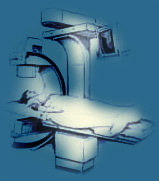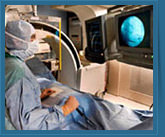|
|
|
|
|
 Understanding Cardiac Catheterization (coronary angiogram) Understanding Cardiac Catheterization (coronary angiogram)
 Services Services |
|
|
|
| |
|
To prepare:
 Prior to your procedure, tests may be scheduled such as electrocardiogram (ECG), Prior to your procedure, tests may be scheduled such as electrocardiogram (ECG),
 and chest x-ray. and chest x-ray.

 Although some patients are hospitalized (inpatients) when they undergo catheterization, Although some patients are hospitalized (inpatients) when they undergo catheterization,
 it is most commonly done as an outpatient procedure. it is most commonly done as an outpatient procedure.
What to expect:
 A nurse will start an intravenous (IV) line in your arm A nurse will start an intravenous (IV) line in your arm
 so that medications and fluids can be administered so that medications and fluids can be administered
 during the procedure. during the procedure.

 The cardiac catheterization room is cool and dimly lit. The cardiac catheterization room is cool and dimly lit.
 The air must be kept cool to prevent damage to the x-ray The air must be kept cool to prevent damage to the x-ray
 machinery that is used during the procedure. You will be machinery that is used during the procedure. You will be
 offered warm blankets to make you more comfortable. offered warm blankets to make you more comfortable.

 You will lie on a special table. If you look above, You will lie on a special table. If you look above,
 you will see a large camera and several TV monitors. you will see a large camera and several TV monitors. |
 |
 You can watch your cardiac catheterization on the monitors. You can watch your cardiac catheterization on the monitors.

 The nurse will clean your skin at the site where the catheter (narrow plastic tube) will be The nurse will clean your skin at the site where the catheter (narrow plastic tube) will be
 inserted (arm or groin). The catheter insertion site may be shaved. inserted (arm or groin). The catheter insertion site may be shaved.

 Sterile drapes are used to cover the site and help prevent infection. It is important that you Sterile drapes are used to cover the site and help prevent infection. It is important that you
 keep your arms and hands down at your sides, under the sterile drapes. keep your arms and hands down at your sides, under the sterile drapes.

 Electrodes (small, flat, sticky patches) will be placed on your chest. The electrodes are Electrodes (small, flat, sticky patches) will be placed on your chest. The electrodes are
 attached to an electrocardiograph monitor (ECG), which monitors your heart rate attached to an electrocardiograph monitor (ECG), which monitors your heart rate
 and rhythm. and rhythm.

 You will be given a mild sedative to relax you, but you will be awake and conscious You will be given a mild sedative to relax you, but you will be awake and conscious
 during the entire procedure. during the entire procedure.

 In some cases, a urinary catheter may be needed during the procedure. In some cases, a urinary catheter may be needed during the procedure.

 The doctor will use a local anesthetic to numb the site. A plastic introducer sheath The doctor will use a local anesthetic to numb the site. A plastic introducer sheath
 (a short, hollow tube through which the catheter is placed) is inserted in a blood vessel in (a short, hollow tube through which the catheter is placed) is inserted in a blood vessel in
 your arm or groin. A catheter will be inserted through the sheath and threaded to the arteries your arm or groin. A catheter will be inserted through the sheath and threaded to the arteries
 of your heart. You may feel pressure as the introducer sheath or catheter is inserted, but you of your heart. You may feel pressure as the introducer sheath or catheter is inserted, but you
 hould not feel pain. Tell the nurse or doctor if you feel any pain. hould not feel pain. Tell the nurse or doctor if you feel any pain.

 When the catheter is in place, the lights will be dimmed and a small amount of contrast When the catheter is in place, the lights will be dimmed and a small amount of contrast
 material will be injected through the catheters into your arteries and heart chambers. material will be injected through the catheters into your arteries and heart chambers.
 The contrast material outlines the vessels, valves and chambers. The contrast material outlines the vessels, valves and chambers.

 When the contrast material is injected into your heart, you may feel hot or flushed for When the contrast material is injected into your heart, you may feel hot or flushed for
 several seconds. This is normal and will go away in a few seconds. several seconds. This is normal and will go away in a few seconds.

 Please tell the doctor or nurses if you feel: Please tell the doctor or nurses if you feel:

  an allergic reaction (itching, tightness in the throat) an allergic reaction (itching, tightness in the throat)

  nausea nausea

  chest discomfort chest discomfort

  any other symptoms any other symptoms

 The x-ray camera will be used to take photographs of the arteries and heart chambers. The x-ray camera will be used to take photographs of the arteries and heart chambers.
 You will be asked to hold your breath while the x-rays are taken. When all the photos You will be asked to hold your breath while the x-rays are taken. When all the photos
 have been taken, the catheter will be removed and the lights will be turned on. have been taken, the catheter will be removed and the lights will be turned on.

 You may have an interventional procedure combined with your cardiac catheterization. You may have an interventional procedure combined with your cardiac catheterization.

|
|
|
After the procedure:
 The catheters and sheath are removed. The catheters and sheath are removed.

| |
 | If the catheter was inserted at the groin: The incision will be closed with applied pressure, suture device or a "plug." A "plug" is a material which works with your body's natural healing processes to form a clot in the artery. You will need to lie flat and keep the leg straight for two to six hours to prevent bleeding (less time if a plug was used). Your head cannot be raised more than 30 degrees (2 pillows high). Do not try to sit or stand.

|
| |
 | A sterile dressing will be placed on the groin area to protect it from infection. The nurse will check your bandage regularly, but call your nurse if you think you are bleeding (have a wet, warm sensation) or if your toes begin to tingle or feel numb.

|
|
 |
 You will need to drink plenty of liquids to clear the contrast material from your body. You will need to drink plenty of liquids to clear the contrast material from your body.
 You may feel the need to urinate more frequently. This is normal. If you are on bedrest, You may feel the need to urinate more frequently. This is normal. If you are on bedrest,
 you will need to use a bedpan or urinal. you will need to use a bedpan or urinal.

 Your doctor will tell you if you are able to return home or will need to stay overnight. Your doctor will tell you if you are able to return home or will need to stay overnight.
 In either case, you will be monitored for several hours after the procedure. In either case, you will be monitored for several hours after the procedure.

 Treatment, including medications, diet and future procedures, will be discussed with you Treatment, including medications, diet and future procedures, will be discussed with you
 prior to going home. Care of the wound site, activity and follow-up care will also be discussed. prior to going home. Care of the wound site, activity and follow-up care will also be discussed.
The cardiac catheterization procedure only takes about 30 minutes, but plan to spend about 5 to 9 hours from the preparation through the recovery time.
|
|
|
|
|